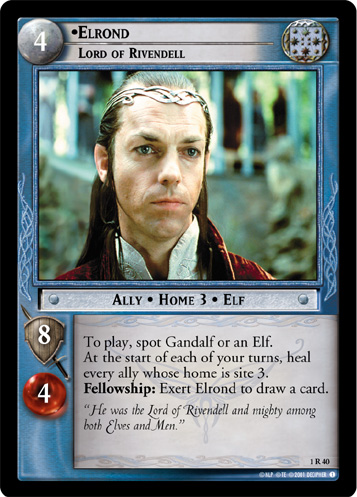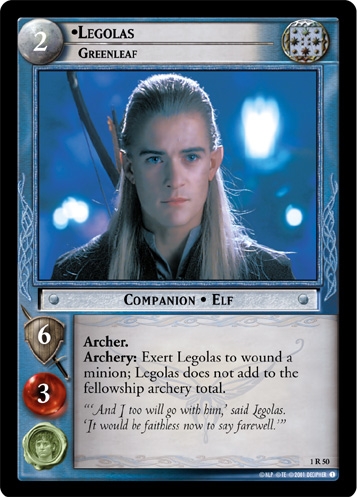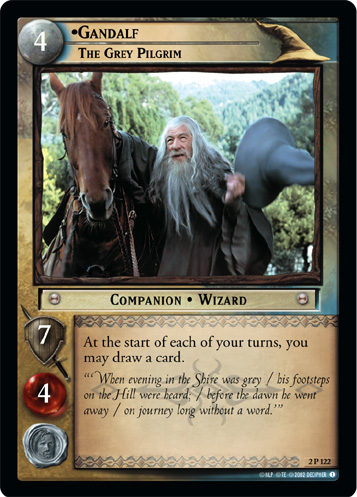Rule of 4: Difference between revisions
imported>Teltura No edit summary |
m (Fixed the links in the article.) |
||
| Line 1: | Line 1: | ||
=The Rule of 4= | =The Rule of 4= | ||
'''The Rule of 4''' was one of the few core rules that was not in the game when it first debuted with | '''The Rule of 4''' was one of the few core rules that was not in the game when it first debuted with [[Fellowship of the Ring]]. In [[Fellowship Block]], [[Allies]] were a much bigger aspect of the game than they were in later sets, meant to represent the aid given to the Fellowship by Elrond and Galadriel in the first movie, which resulted in players using allies almost universally. After all, why not pack your deck full of allies? There is no limit to the number that you can have in play at once (whereas the Fellowship is restricted by the [[Rule of Nine]]) and their special abilities can often be used to great effect. | ||
There was one card that was particularly useful because of a combination of reasons, and that was Elrond, Lord of Rivendell | There was one card that was particularly useful because of a combination of reasons, and that was {{Card|Elrond, Lord of Rivendell}}. Any deck packing Elves or [[Gandalf]] could use him, and due to the prevalence of {{Card|Legolas, Greenleaf}}, that meant practically everyone could use him. On the turn that you dropped Elrond, you could draw 3 cards, and if any of those were other copies of Elrond, you could discard to heal and draw more. Put this in combination with any other drawing mechanism and you could easily play the turn with double the normal hand limit. There are hardly any strategies where this did not work in the player's favor, and so Agent Smith rose to huge popularity. | ||
To combat this, Decipher ruled sometime before the release of Realms of the Elf-Lords to instigate a new rule, known as the '' | To combat this, Decipher ruled sometime before the release of Realms of the Elf-Lords to instigate a new rule, known as the '''Rule of Four''': no more than 4 cards can be put into your hand during the Fellowship phase. This includes drawing from the draw deck, recovering from the discard pile, or taking cards into hand from play. Cards that play directly from the draw deck or discard pile do not count towards this rule, only cards placed "into hand". This also does not affect cards drawn "at the start of your turn" (such as {{Card|Gandalf, The Grey Pilgrim}}) , as this happens before the Fellowship phase. | ||
For this reason, card cycling is usually done on the Shadow side of play, since there is no limit to the number of cards that can be put into hand while acting as Shadow player. A list of cards that are affected by the Rule of 4 are shown below. | For this reason, card cycling is usually done on the Shadow side of play, since there is no limit to the number of cards that can be put into hand while acting as Shadow player. A list of cards that are affected by the Rule of 4 are shown below. | ||
See also draw deck, [[draw]], discard pile, [[hand]], Fellowship phase. | See also draw deck, [[draw]], discard pile, [[hand]], Fellowship phase. | ||
[[Category: Comprehensive Rules References That Need Fixed]]'''From the [[comprehensive_rules_4-0#the_rule_of_4|Comprehensive Rules 4.0]]:''' | [[Category: Comprehensive Rules References That Need Fixed]]'''From the [[comprehensive_rules_4-0#the_rule_of_4|Comprehensive Rules 4.0]]:''' | ||
Revision as of 22:03, 15 January 2022
The Rule of 4
The Rule of 4 was one of the few core rules that was not in the game when it first debuted with Fellowship of the Ring. In Fellowship Block, Allies were a much bigger aspect of the game than they were in later sets, meant to represent the aid given to the Fellowship by Elrond and Galadriel in the first movie, which resulted in players using allies almost universally. After all, why not pack your deck full of allies? There is no limit to the number that you can have in play at once (whereas the Fellowship is restricted by the Rule of Nine) and their special abilities can often be used to great effect.
There was one card that was particularly useful because of a combination of reasons, and that was Elrond, Lord of Rivendell (1R40)
 . Any deck packing Elves or Gandalf could use him, and due to the prevalence of Legolas, Greenleaf (1R50)
. Any deck packing Elves or Gandalf could use him, and due to the prevalence of Legolas, Greenleaf (1R50)
 , that meant practically everyone could use him. On the turn that you dropped Elrond, you could draw 3 cards, and if any of those were other copies of Elrond, you could discard to heal and draw more. Put this in combination with any other drawing mechanism and you could easily play the turn with double the normal hand limit. There are hardly any strategies where this did not work in the player's favor, and so Agent Smith rose to huge popularity.
, that meant practically everyone could use him. On the turn that you dropped Elrond, you could draw 3 cards, and if any of those were other copies of Elrond, you could discard to heal and draw more. Put this in combination with any other drawing mechanism and you could easily play the turn with double the normal hand limit. There are hardly any strategies where this did not work in the player's favor, and so Agent Smith rose to huge popularity.
To combat this, Decipher ruled sometime before the release of Realms of the Elf-Lords to instigate a new rule, known as the Rule of Four: no more than 4 cards can be put into your hand during the Fellowship phase. This includes drawing from the draw deck, recovering from the discard pile, or taking cards into hand from play. Cards that play directly from the draw deck or discard pile do not count towards this rule, only cards placed "into hand". This also does not affect cards drawn "at the start of your turn" (such as Gandalf, The Grey Pilgrim (2P122)
 ) , as this happens before the Fellowship phase.
) , as this happens before the Fellowship phase.
For this reason, card cycling is usually done on the Shadow side of play, since there is no limit to the number of cards that can be put into hand while acting as Shadow player. A list of cards that are affected by the Rule of 4 are shown below.
See also draw deck, draw, discard pile, hand, Fellowship phase.From the Comprehensive Rules 4.0:
Some card effects allow you to draw cards in the fellowship phase. You cannot draw (or take into hand) more than 4 cards during your fellowship phase.
This applies to cards taken into hand by any means. This does not apply to cards drawn “at the start of each of your turns.”
Cards Limited by the Rule of 4
Dwarven
- Delving
- Wealth of Moria
- Great Works Begun There
- Book of Mazarbul
- Dwarven Foresight
- Ever My Heart Rises
- Search Far and Wide
- Defending the Keep
- Calculated Risk
- Loyalty Unshaken
- Aggression
- Ring of Guile
- Gimli, Opinionated Guide
Elven
- Arwen, Maiden of Rivendell (D)
- Elrond, Lord of Rivendell
- Foul Creation
- Alliance Reforged
- Elrond, Keeper of Vilya
- Gift of Foresight
- Strands of Elven Hair
- The Mirror of Galadriel, Dangerous Guide
Gandalf
- Barliman Butterbur, Prancing Pony Proprietor
- Ottar, Man of Laketown
- Questions That Need Answering
- Risk a Little Light
- Speak "Friend" and Enter
- Saved From the Fire
- The Art of Gandalf
- Final Account
- Dasron, Merchant from Dorwinion
- Return to Us
- Momentous Gathering
- Scintillating Bird
- Ship of Smoke
Gollum (Free Peoples)
Gondor
Rohan
Shire
| Game Concepts |
|---|
| Play Area | ||||
|---|---|---|---|---|
| Piles | Draw Deck | Adventure Deck | Discard Pile | Dead Pile |
| Other | Fellowship | Support Area | Twilight Pool | Adventure Path |
| The Turn Sequence | ||||||
|---|---|---|---|---|---|---|
| Fellowship Phase | Shadow Phase | Maneuver Phase | Archery Phase | Assignment Phase | Skirmish Phase | |